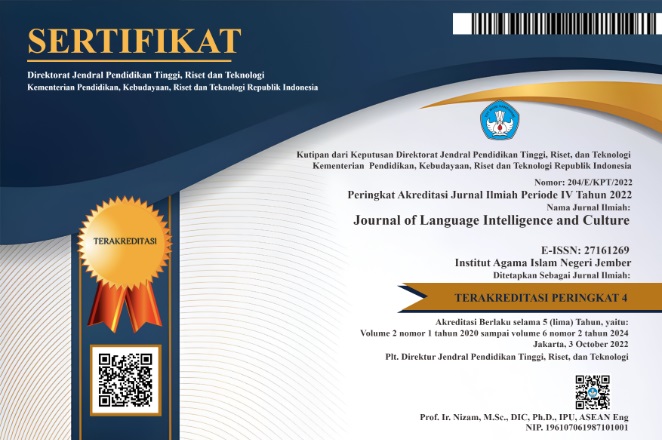Lexical Density of Reading Materials in An English Textbook: A Content Analysis
DOI:
https://doi.org/10.35719/jlic.v6i2.104Keywords:
Lexical density, reading materials, English textbookAbstract
In reading, students are required to learn to comprehend the content of the text. Lexical density is one of the factors that influences students’ reading comprehension. Lexical density is a condition of words’ proportion in a text, which shows the ratio of content words (CW) and grammatical function words (GFW). This research used the “Passport to the World” English textbook for the 8th grade of junior high school to be analyzed. This study aims to find out the genres of reading materials offered by the curriculum 2013 found in the textbook and to examine the lexical density of the reading materials in the textbook. A qualitative approach was applied, while content analysis was used as the research design. Data were collected with document analysis. The findings showed that there are 3 genres of reading materials, among 5 genres offered by the curriculum 2013, included in the textbook such as descriptive, recount, and functional texts in the form of announcements. From those, it was found that two texts were categorized as low lexical density, 11 texts were categorized as medium lexical density, and four texts were labeled as high lexical density. In addition, the composition of this text did not reach the ideal ratio of 1:2:1 for index difficulty. However, this textbook can still be suggested to be used in the class with some usage modifications in the classroom.
References
Ary Donal, Lusy Cheser Jacobs, Chris Sorensen, and Asghar Razavieh. (2010). Introduction to research in Education, 8th edition. Belmont, USA: Wadsworth.
Eggins, S. (2004). Introduction to systemic functional linguistics, 2nd edition. New York.
Fang, Z. (2005). The challenge of reading disciplinary texts. Australian Journal of Language and Literacy, 28(1), 33-37.
Fang, Z. (2008). Going beyond the Fab Five: Helping students cope with the unique linguistic challenges of expository reading in intermediate grades. Journal of Adolescent & Adult Literacy, 51(6), 476-487.
Fitriani, E. (2015). Factors Influencing Reading Comprehension Difficulties in Junior High School Students. Journal of English Language Teaching, 4(1), 75-85.
Grabe, W. (2009). Reading in a second language: Moving from theory to practice. Cambridge University Press.
Halliday, M. A. K. (1985). Spoken and written language. USA: Oxford University Press.
Hartati, S. (2019). Developing test items for EFL students in Indonesia: Practices and challenges. Journal of English Language Studies, 4(2), 157-170.
Heinle, Thomson. (2000). Designing Language Course: A Guide for Teacher. Canada: Kathleen Graves.
Heiton, J. B. (1988). Writing English Language Test. London and New York, Longman Group UK Limited.
Ibarhim, M. W., Abdullah, U., & Amalia H. (2024). Factors Causing Reading Comprehension Difficulties Among the Seventh Graders. PROJECT (Professional Journal of English Education). 7(2). 496-501. DOI: https://doi.org/10.22460/project.v7i2.678
Johansson, V. (2008). “Lexical diversity and lexical density in speech and writing: A developmental perspective” Lund University, Department of Linguistics and Phonetics, 53, 61-79
Khamahani, Ghafar. (2015). A Corpus-Based Analysis of Tehran Times and Azeri News Headlines: Focus on Lexical Density and Readability, International Journal of Humanities Social and Education (IJHSSE) 2(1). 12-16.
Khan, Sajid I. (2020). Part of Speech, first edition, edited by Javaria Hanan, literary English.
Knapp, P & Watkins, M. (2005). Genre, Text, Grammar: Technologies for Teaching and Assesing Writing. Sydney: University of New South Wales Press.
Miskiyah, N. & Amalia, T. Z. (2022). Analyzing Lexical Density and Readability of Reading Texts in English Textbook “Stop Bullying Now” by Mahrukh Bashir. Journal of English Teaching and Learning Issues, 5(1). 39-50. DOI: http://dx.doi.org/10.21043/jetli.v5i1.12199
Mol, S. E., & Bus, A. G. (2011). To read or not to read: A meta-analysis of print exposure from infancy to early adulthood. Psychological Bulletin, 137(2), 267-296. doi: https://doi.org/10.1037/a0021890
Mulyadi, D. (2019). The analysis of English textbooks in Terms of Genre and Cultural content. Journal of English Language Teaching and Linguistics, 4(3), 245-256.
Pratiwi, A. H. (2014) Lexical density of English textbook of second year of senior high school. Unpublished Thesis. Dian Nuswontoro University.
Prastikawati, E. F., & Fauziati, E. (2016). An evaluation of English textbook used in junior high school based on the curriculum 2013. Jurnal Pendidikan Bahasa Inggris Proficiency, 1(2), 1-11
Richards, J. C. (2001). The role of textbooks in a language program. Cambridge.
Sholichatun, S. (2011). “Content analysis of reading materials in English on sky textbook for junior high school”. Thesis, Semarang: IAIN Walisongo.
Snow, C. E., Burns, M. S., & Griffin, P. (1998). Preventing reading difficulties in young children. National Academy Press.
Syarif, H. (2018). “Lexical Density v.s. Grammatical Intricacy: how they are related?” Padang: FBS Universitas Negeri Padang, 2018.
Ure, J. (1971). Lexical density and register differentiation. In G. E. Perren & J. L. M. Trim (Eds.), Applications of linguistics (pp. 443-452). Cambridge University Press.
Downloads
Published
How to Cite
Issue
Section
License
Copyright (c) 2024 Yuni Lailatul Maufiroh, Bannaga Taha Elzubair Hussen, Praptika Septi Femilia

This work is licensed under a Creative Commons Attribution-ShareAlike 4.0 International License.













